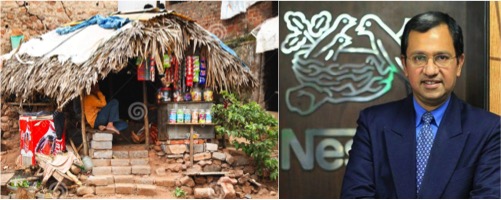Amid subdued growth in the urban markets, Nestlé India is looking to aggressively expand its footprint in the rural markets, with a target to reach 1,20,000 villages in the next 2-3 years, bolstered by targeted products as well as campaigns, Suresh Narayanan, Chairman and Managing Director, Nestlé India said.
Speaking to select mediapersons, Mr. Narayanan said for the next few quarters, the rural market is expected to continue to outpace urban markets in terms of growth. The company had taken steps in the last 2-3 years to enhance the rural footprint and the number stood at 89,000 villages in 2019, from 1,000 villages in 2017, he added.
“The target that we have got is to reach 1,20,000 villages — that is all villages with a population of more than 5,000. That is the kind of reach we are looking to establish in the next 2-3 years. There is a very strong determination as far as expanding our rural footprint is concerned,” Mr. Narayanan said.
The company, for which currently a third of its business comes from the urban market, rural markets have shown accelerated growth during the entire period of the pandemic. In the December quarter, the company’s overall domestic sales grew by about 10%. While growth in the urban market stood at 6%, rural sales growth was almost twice that.
Talking about the efforts to expand footprint in rural markets, Mr. Narayanan said this will be done not only via expansion of the distribution network, but also by tweaking the relevant parts of the portfolio. “The work is on, in terms of renovating and innovating some products that we will put out in the rural and semi-urban markets. We will look at different models and channels of distribution to access smaller markets and finally communication thrust of the company will also go towards campaigns, messaging and advertising that will be more rural centric,” he added.
Replying to a query on the growth of industry, he said, “I’m a firm believer in the consumption story of this country.” He said every research notes that the packaged goods market is set to double in the next 5-10 years from about $35 billion now, to $70 billion. “Because of the pandemic there could be some delay in that, but I don’t think we will be denied that…And there are a few demographic and economic reasons why that would probably be the case.”
He pointed out that between 2018-19 and 2030, India is expected to add almost 140 million households to the aspiring and the affluent class in the country. And the bottom of the pyramid, which is really those deprived, is going to shrink. “This clearly means that there is going to be an increasing proclivity towards the consumption of packaged goods, and also of branded goods of whatever kind during this period,” he said.
He further added that rural India and semi-urban India were really areas to watch out for in terms of continued resilience over a period of time.
Talking about the urban markets, he said they had been badly affected because of the lockdown and the migration that took place. Mr. Narayanan said that there were already signs of improvement and urban markets should start to come back in the next couple of quarters provided “nothing goes terribly wrong as far as the evolution of pandemic” is concerned.
Source : The Hindu

